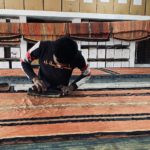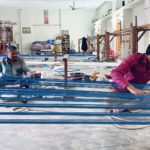From cotton to weave: the process
As with all weaving, it all begins with the yarn. Traditionally, bhujodi weaves only used wool but now cotton, silk and wool are all mixed.
Here a spinner converts camel wool into yarn. It is all in the play of the hands and the tension with which she pulls.
Then comes the dyeing. Bhujodi weavers have an intimate relationship with dyes. Every morning, the dyer visits the earthenware vats to figure out which dye is ready to give up the yarn that has been soaking in it for hours or days. They pull out the yarn with tongs and examine the colour. Depending on weather, some vats want to embrace the yarn for a little longer. Others have given the yarn all it needs.
Most weavers, even experienced ones love the dyeing process, particularly natural dyes, which are easier on their hands, health and the environment. The ritual of mixing dye, checking if it is ready and stirring the dye pots in the morning is meditative and comforting.
Watch how a weaver here explains the difference between natural dyed yarn and chemical dyed yarn. It is all in the texture and shading.
Once the coloured yarn is ready comes the difficult tasks of checking the strength of each thread, making sure that it doesn’t break– and if it does, reconnecting the threads by reattaching them using a twist of the fingers.
This task of checking each individual thread is perhaps the most painstaking part of the process. It involves deftness, an eye for detail and a meticulousness that allows for no thread to go untested– lest it tear or break on the loom.
Once the fabric is finished at the loom, several master weavers check the weave to make sure that all is well, that the motifs are where they should be and the fabric is strong.
Bhujodi weaves are not as wide as a saree. Usually these narrow weaves are stitched together using the classic herring-bone motif.
In the end comes the ironing of the weave, just before it gets on the shop floor. Here a couple take the finished weave and polish it a bit further before sending it onwards for the customer’s pleasure.





